
Authored by:
Robert Koenigsberger, Managing Partner & Chief Investment Officer
Mohamed A. El-Erian, Chair
Petar Atanasov, Director & Co-Head of Sovereign Research
Kathryn Exum, Director & Co-Head of Sovereign Research
October 4, 2023
Decoding the Global Macro Environment: A Top-Down Perspective and the Related Implications for Emerging Markets Heading into 4Q 2023
Top-Down Observations
The global economy and markets benefited in the third quarter from an impressive U.S. growth performance. On the domestic front, this enabled the economy to navigate well the Federal Reserve’s most concentrated rate-hiking cycle in decades, as well as the spillovers from the banking volatility in March and April. This, in turn, led to a substantial reduction in analysts’ recession probabilities. On the global front, it moderated growth concerns and reduced worries about a credit crunch, despite several challenges, including disappointing economic performance in China. Additionally, in the financial markets, it prevented credit and liquidity risks from compounding the interest rate risk that had challenged various asset classes.
Continued growth in the United States will play a pivotal role in sustaining relative global economic stability in the fourth quarter and beyond. After all, Chinese growth is unlikely to rebound anytime soon, especially given the limitations on the authorities’ willingness and effectiveness in implementing a substantial stimulus effort. Europe faces uncomfortably high risks of stagflation, Japan must execute a smooth exit from its yield curve control (YCC) policy regime and, amidst ongoing tensions between China and the United States, many countries are navigating a gradual fragmentation of the global economic and financial order.
The positive news is that while the pace of U.S. economic growth may decelerate somewhat in the coming months, there are no inherent reasons for the economy to fall into a recession. Job opportunities abound, wages are on the rise, and most businesses maintain solid balance sheets.
The primary risk to U.S. economic growth in the near future arises from the possibility of the Federal Reserve going too far in its rate-hiking cycle as it embarks on the “last mile” in its battle against inflation. This risk is further complicated by genuinely challenging questions surrounding the design and impact of monetary policy, spanning from assessing the lagged effects of the most concentrated rate-hiking cycle in decades to accurately estimating the r-star, understanding the impact of quantitative tightening (QT), and specifying an appropriate inflation target in a structurally challenged world.
Much of what unfolds in the coming months and beyond will also hinge on how the global economy manages the transition from a previous era marked by insufficient aggregate demand to the current era characterized by inadequate aggregate supply. This transition is further complicated by the changing globalization, the energy transition and debt overhangs, alongside the increasing tendency of some countries to prioritize politics over economics. It’s a world where the resilience of balance sheets will remain crucial, where disparities should be expected both within and among countries (including cases of distress), and where prudent security selection and structuring will prove very important.
Themes Influencing Investment Decisions in 4Q 2023
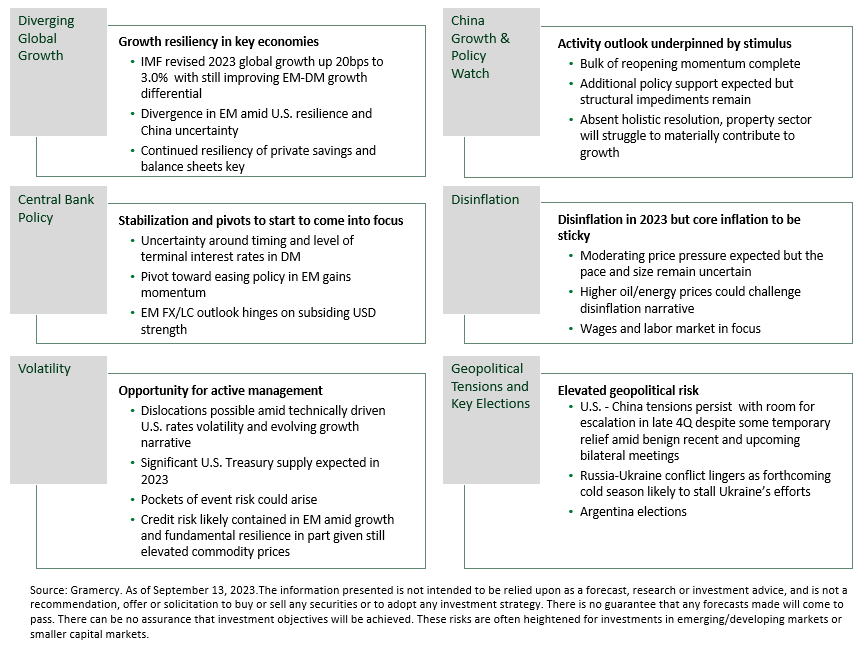
Moderate global growth amid regional divergence and different landing scenarios
Global growth is expected to finish 2023 in the 3% area despite slowdowns in the Euro Area and China, thanks predominantly to the resilience of the U.S. economy. The important EM-DM growth differential is in positive territory thanks to the normalization of EM fundamentals to pre-pandemic levels and resilient growth trajectories in many major EM economies as well as a projected slowdown in developed markets (see Exhibit 1). Economic resilience despite tighter financing conditions is likely explained in part by still healthy balance sheets, fiscal spending in many economies, and wage gains combined with the continued drawdown of excess savings which has supported consumption and economic activity.
Looking ahead to 4Q, we expect global growth to remain subdued amid a structural limitation on stimulus in China and a potential recession in the Euro Area. While Chinese stimulus has been forthcoming in a piecemeal and targeted fashion, we see downside risks to the growth target of 5%, with limited spillover effects on certain export-oriented EMs. Our base case envisions a soft landing in the U.S. engineered by the Fed to quell inflationary pressure while sustaining decent demand side activity underpinned by positive wage growth and a strong labor market.
Exhibit 1: Higher EM-DM growth differential amid moderating global growth
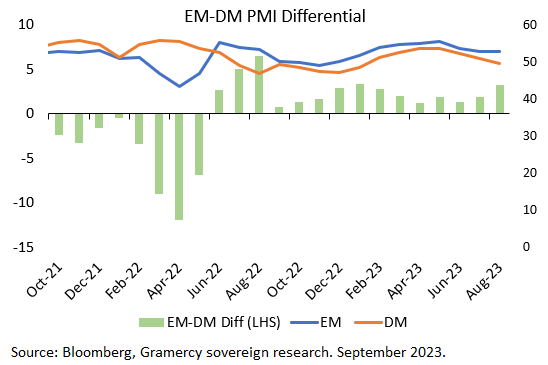
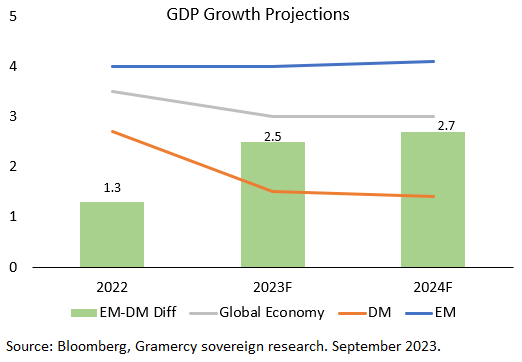
Monetary policy pivots to gain momentum as inflation moderates across EM, but energy price developments are a key risk to monitor in 4Q
The moderation in inflation dynamics across EM observed since the start of the year held up during the last quarter for most jurisdictions and we expect it to continue in 4Q. For most major emerging markets, year-on-year headline inflation is back in single digit territory, with some already below 5%, and is projected to decline further into 2024 (see Exhibit 2). A handful of major EMs are expected to see a re-acceleration of price pressures next year, but only in economies that are already exhibiting relatively low levels. Overall, although inflation levels in 4Q and early next year are likely to remain above current targets for many EM central banks, we expect that markets will focus primarily on the continuing disinflation trajectory that should empower the authorities to continue with or embark on growth-supporting monetary policy easing cycles, unwinding the significant tightening delivered over the last couple of years. The main risk to this relatively benign outlook comes from global oil/energy prices that have materially increased since late August and could impact domestic inflation in 4Q and beyond, especially for net energy importing EM economies.
In DM, inflation dynamics have also improved, but to a lesser degree compared to EM, while strong labor market conditions are likely to keep the systemic central banks in a more hawkish mode compared to their EM colleagues. While the most concentrated DM rate-hiking cycle in decades is seemingly in the rear-view mirror, EM assets would likely need clear signals to emerge that the Fed and ECB “are done hiking” and that the global economic activity can manage the lagged effects of multi-month policy tightening without suffering major downside surprises.
Exhibit 2: EM inflation has been consistently lower than market expectations in 1H23
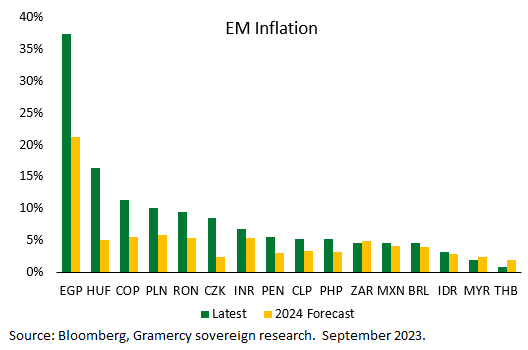
Some of the major Latin American economies have offered investors attractive real interest rates since the start of the year, and looking forward to the last quarter, they are now being joined by a handful of CEE peers. Those EM economies are entering the fourth quarter with stronger forward-looking real interest rate buffers, anchoring an overall FX-supportive fundamental backdrop at the start of 2H 2023 (see Exhibit 3).
Exhibit 3: Significant forward looking real rates in EM as inflation comes down
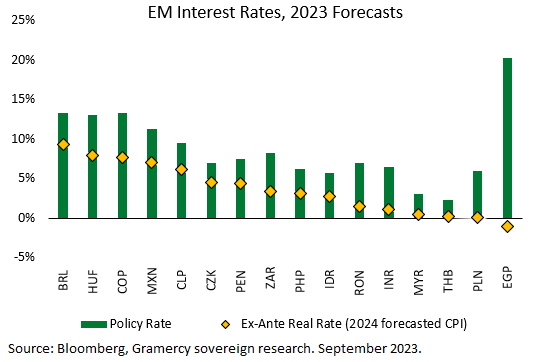
For the first time in years, there are almost no major emerging market economies with negative real rates on a forward looking basis (using projected 2024 headline inflation) and a few of them have real interest rates in excess of 5%, which should support the attractiveness of EM assets in general and local currency assets in particular. However, as we argued in our prior outlook, an essential element of the overall investment outlook for EM local assets in 4Q will remain the direction of the USD and market assessment on the probability that DM rates have peaked.
Beijing’s incremental approach to economic stimulus likely to remain unchanged
There has been a raft of measures announced over the past few weeks to support economic growth in the Chinese economy. However, the authorities remain reluctant to use the “bazooka” approach of the recent past given their strategic objective of reducing leverage in the economy and preserving financial stability. These measures include PBOC rate cuts, a push for banks to increase lending to companies in strategic sectors and SMEs, easing property restrictions, a policy push for the issuance of special infrastructure bonds by local governments and funding support for property developers, among others. While there have been nascent signs of stabilization on the front of industrial production, retail sales, aggregate credit growth and the urban unemployment rate, it might be premature to declare that this foreshadows a sustained recovery trajectory given the lack of an outsized policy response unlike in previous downturns, limited fiscal space in debt laden local governments, and a slowing job market.
Depending on the pace of domestic and external economic activity in 4Q, stimulus could amount to RMB 1-3 trillion comprised of a mix of additional monetary, property and fiscal measures in part leveraging policy bank lending to state owned enterprises. Announcements are likely to remain ad hoc in the short-term while a more strategic solution could begin to take shape during the year-end policy meetings, setting the stage for execution into 2024. This all points to 2023 growth near the government’s target of 5% or slightly lower. If stimulus size or effectiveness falls short and at the same time global growth stalls, the government could narrowly miss the target, as it did last year.
On geopolitics, we expect tensions over Taiwan or U.S. – China relations to remain managed despite latent risks. Focus on Taiwan and U.S. elections could bring these risk factors closer to the surface later in the year and into 2024. In the meantime, we continue to anticipate Xi Jinping to leverage opportunities to enhance his clout on international relations, particularly as the EU and Western leaders accept China’s role as a mediator in the Ukraine-Russia conflict.
Pivotal Argentina elections in October
The August primary elections (PASO) produced significant outperformance by anti-establishment libertarian candidate Javier Milei (30% support vs. polls <20%), closely followed by opposition JxC with 28% and the ruling coalition at 27%. Right-leaning Patricia Bullrich has comfortably secured the mainstream opposition candidacy over more centrist Horacio Larreta, while Sergio Massa, the Finance Minister in the ruling leftist administration, will be its candidate in October.
In the aftermath of the vote, the Central Bank of Argentina, BCRA, moved forward with a 20% devaluation of the official FX rate and a 21% hike in the policy rate combined with commitment from Massa to fiscal conservatism with a primary balance in 2024. The devaluation has driven recent inflation to multi-decade highs, which is likely to favor Javier Milei from a political perspective, in our view. Given general economic malaise and the primary results, Milei appears set to enter the 1st round on October 22nd as favorite, but the election remains wide open with Bullrich and Massa engaged in a fierce battle to make it to a likely second round on November 19th.
Looking ahead, we think that from a top-down perspective the PASO results point to a strong rejection of the political/economic status quo, a call for change, and a potential policy shift to the right. In the most simplistic sense, this should be constructive for markets and help support a “buy the dip” mentality. However, the very fragile macroeconomic situation amid the transition period and the tight race leaves uncertainty very high. Milei’s radical policy stances (dollarization, abolish BCRA etc.) combined with lack of clarity over his ability to govern effectively due to his erratic approach and questionable willingness to listen to advisors leaves substantial execution risk in the event of his presidency.
In the event of a Bullrich presidency, we continue to see decent prospects for execution of a stabilization plan with room for coalition building with Milei, although the ability for JxC to retain full unity is unclear in this scenario. Similarly, in the case of a Milei win, prospects for pragmatism and partnership with Bullrich remain. However, uncertainty is elevated in this regard as views remain mixed on his willingness to listen to pragmatic advisors or compromise to build a coalition. As for Massa, if he continues to move toward the center as his initial actions and navigation of the IMF process thus far suggest, we see benefits in continuity with an acknowledgement for a much-needed pivot to stabilization. As the election dates get closer, the market will be watching for continued confirmation of this during 4Q.
The war in Ukraine likely to enter another “frozen stage” as winter weather settles in
Ukraine’s spring/summer counteroffensive against Russian defenses in the south and south-east of the country has yielded limited success, but generally has tended to fall short of liberating large swaths of territory as Kyiv has hoped. As such, we expect that in the coming months the conflict will likely settle into another “frozen period” with limited military action across the frontline as both sides try to replenish war supplies and reinforce their respective international support networks. The ability of Ukraine to launch a new offensive effort in the future is now more questionable and will remain a function of continued financial and military support by NATO members. For the Kremlin, attention and geopolitical calculations might be shifting to the upcoming U.S. presidential elections and the ability to maintain pressure on Ukraine over the medium-term, among other factors. Overall, a diplomatic solution to the conflict unfortunately remains extremely unlikely in the near-term, in our view. As such, geopolitical risks for markets from the war will linger, but are likely to fade from headlines in 4Q as Ukraine’s counteroffensive concludes.
Investment Strategy Review and Outlook
Multi-Asset Strategy
We continue to believe there are high expected returns in EM credit as a result of the dislocation recovery in 2022. Volatility is the top-down macro theme where we have the most confidence due to “unusual uncertainty” and bouts of illiquidity in the marketplace.
Our objective remains to capture the embedded returns in the dislocation recovery, but to do so in a fashion whereby we participate in a material amount of the upside but continue to limit the correlation to a challenging/draw-down market. We look to do so though our barbell which is anchored in high yielding asset backed lending and high conviction EMD. On the other side of the barbell, we continue to lean-in on opportunistic and special situations only when they present themselves as asymmetric opportunities. Lastly, we are overlaying put-spreads on EMB and SPY to mitigate any big moves to the downside. Combined, this gives us confidence that we can capture the high, expected returns but do so without making any non-recoverable mistakes.
Over the past quarter our active approach led us to: capitalize on a down market, fund additional asset backed/private credit investments, fund an arbitration claim, take profits opportunistically in both corporates and sovereigns, reduce performing public credit, and re-introduce put-spread protection into our global hedge to help smooth over any potential public market volatility leading into crucial September CPI and FOMC events.
As the quarter comes to an end, the strategy has dry powder available. Private credit and special situations are slightly over our strategic weight due to current market dynamics, recent performance and what we believe are several well-structured, asymmetric opportunities. Opportunistic and public credit are materially under our strategic weight. We prefer high yield over investment grade, and corporate over sovereign. Our hedge seeks to provide robust protection into 4Q with uncertainty around a soft landing/recession/stagflation but doing do so with limited/known premium/expense and gearing north of 10x.
Emerging Markets Debt
The third quarter of 2023 was rocked by a new wave of U.S. rates volatility that the market was largely not expecting. A better-than expected U.S. CPI print was released at the beginning of July showing headline inflation in the U.S. falling to 3%, the lowest since March 2021. While the Fed delivered its expected 25bps rate hike later in July, the earlier CPI print raised market hopes that the Fed might have reached the end of its rates tightening cycle, making the July hike a “one and done” situation. At the same time, sentiment for emerging markets fixed income was bolstered by better growth prospects and falling inflation expectations in emerging markets that set a path for a pivot in rates in key jurisdictions.
Unfortunately, a fast and furious sell-off in 10 and 30-year Treasuries (+22bps and +28bps, respectively), during the first week of the month quickly reversed positive global risk sentiment. The Treasury move was driven by the release of the U.S. government’s fiscal plan which showed much higher than expected financing needs, increasing fears over future UST supply, and coincided with Fitch’s downgrade of U.S. sovereign debt from AAA to AA+. While a softer than expected July jobs report provided a short reprieve, 10 and 30-year Treasuries continued their climb higher, reaching levels not seen in fourteen years (4.3% and 4.4%, respectively), as supply concerns were compounded by concerns over (1) Japanese demand for U.S. Treasuries post the BOJ’s tweak in yield curve control policies, (2) stronger economic data signaling a push out of recession risks and reinforcing the higher for longer rates narrative and (3) concerns over upside risks to inflation on the back of rising commodity prices driven by supply side factors. The Treasury market finally took a breather towards the end of August on the back of soft PMIs in the U.S., EU and the UK but started widening again at the beginning of September as prospects for another hike in November started increasing after a strong U.S. ISM services print.
In the midst of this volatile U.S. rates backdrop and the dominance of the higher rates for longer narrative in the U.S., it is unsurprising that EM local sovereigns underperformed with the JPM GBI-Broad Diversified Index down 1.2% QTD. EM corporates outperformed during the quarter with the JPM CEMBI Broad Diversified Index up +0.4% on the back of its low duration (only 4.8 years) versus EM sovereigns which were down marginally at -0.1% QTD (duration of 6.2 years). As expected, the HY segments of both EM sovereigns and corporates outperformed IG during the quarter given a mix of lower duration and higher carry present in the HY segments. HY EM sovereigns and corporates returned +2.0% and 1.6% QTD, respectively, versus IG sovereigns and corporates which returned -2.1% and -0.4% QTD, respectively.
While we are of the opinion that the Fed remains close to the end of the rate hiking cycle and that U.S. rates downside from supply is capped by the potential demand arising from duration rotation trades that would likely occur at more elevated levels, volatility should remain a central theme for the remainder of 2023 as the market (and the Fed) digest and react to each new economic data print. In this environment, active management continues to be critical to both managing the risks posed to portfolios and to harness the opportunities that may arise from any dislocations. During times such as these, we are particularly focused on generating alpha through our rigorous bottom-up investment process.
Supply technicals remain supportive. While supply in the EM fixed income market has resumed more strongly in September, EM gross supply forecasts for 2023 remain well below the 5-year average for 2017 through 2021 at -27% for EM sovereigns and -44% for EM corporates. Furthermore, EM gross issuance has primarily been skewed to IG with 73% of gross sovereign issuance and 79% of gross corporate issuance being IG. After over two decades of growth, net financing is expected to be negative for a second year in a row for EM corporates at -$118 billion. Furthermore, performance risk remains skewed to the upside as significant EM hard currency outflows of -$43 billion in 2023 and -$13 billion YTD indicate that accounts remain underweight emerging markets fixed income.
From a fundamental perspective, EM corporates, on average, have proven to be resilient with only marginal deterioration in credit metrics. Both gross and net trailing twelve-month leverage increased only 0.1x from 4Q 2022 to 2Q 2023. As such, leverage remains below pre-pandemic levels. It is interesting to note that while a China slowdown has negatively impacted overall market risk sentiment and commodity prices are down versus historical highs from 2021 and 2022, supply side factors have kept commodity prices at elevated levels; thus, reducing the impact of a China slowdown on commodity producers in emerging markets. Nonetheless, there has been a more pronounced deterioration in the lower end of the quality spectrum in EM corporates and caution is still warranted for smaller high yield issuers that have short-term refinancing needs. For sovereigns, we believe that the bulk of the fundamental deterioration has already occurred, and valuations reflect weaker credit profiles. With most of the relevant sovereigns under IMF programs, we are constructive on the path forward but remain highly selective in this space.
Exhibit 4: Global Market Index Returns
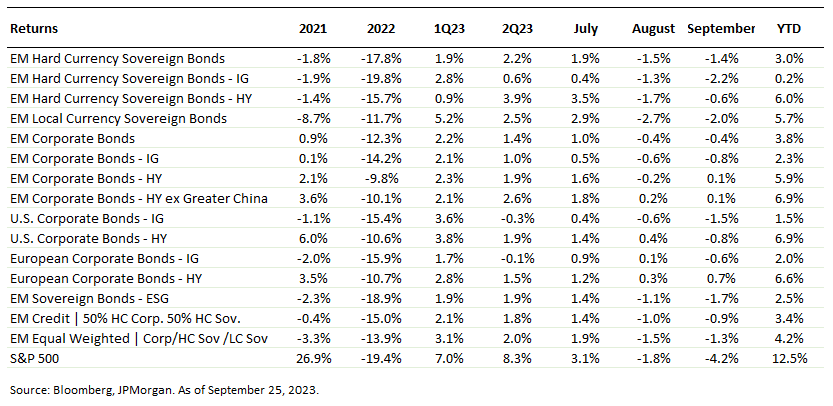
The coming quarter will be important to receiving more clarity on the direction of the global economy, and more importantly, on the U.S. economy. The market will be scrutinizing every piece of macro data released to see if the U.S. economy is moving more clearly in the direction of a soft landing or a deeper recession to try and gauge where U.S. rates policy might be headed as well. Some focus is also likely to be placed on supply side dynamics for U.S. Treasuries, which did not come to the forefront of investors’ minds until this past quarter.
Given the continued uncertainty and propensity for volatility under these circumstances, we remain highly tactical and agile in the way we are managing our portfolios and will focus on bottom-up credit selection as a means of generating alpha for clients.
Capital Solutions
The macro backdrop continues to be driven by the lack of clarity regarding the Fed’s path on inflation fighting. Its effects on the global economy have continued to keep a lid on the new issue market for EM corporates during the third quarter. As the lack of access prolongs itself, even after 2022 showing the largest decline in EM corporate issuances since 2009, the private credit markets continue to prosper. Corporates that have been postponing their CAPEX investments or are waiting to refinance their debts hoping for a better market, have had to seek private credit solutions, even in the case of larger corporates with sophisticated capital structures and enhanced corporate governance. We have been able to benefit from these market dynamics and deploy new loans to larger corporates and regional companies, including the largest companies in Latin America, which in previous years would not have considered our highly structured and collateralized facilities but rather relied on capital market access as was the case over the past decade.
As we highlighted in the previous quarterly outlook, in today’s market, larger corporates value our speed and certainty of execution and have proven their willingness to pay the additional cost to access mid to long-term capital. Our funding is viewed as a resilient source to be used as a bridge to better market access. Furthermore, some borrowers finally accept more restrictive facilities as long-term capital, based on their view of the market conditions for the next 24 to 36 months. We are in the documentation phase and looking to draw down more than ten loans to corporates with over $100 million in EBITDA, highlighting the competitive advantage of private credit in the current cycle. As a result, we have been able to further diversify within our target jurisdictions to cater to a wider universe of companies, including entities with over $1 billion in market cap. The most notable consequence has been the increase in credit quality throughout our portfolio, while maintaining attractive mid-teen returns with enhanced collateral packages.
Separately, and in line with private credit portfolio construction of developed markets, approximately one third of our portfolio is invested in resilient cash flow-generating asset-backed instruments within EM financial services companies. These asset-backed instruments are geared towards shorter-term consumer products, trade finance, leasing, factoring, etc.
During the third quarter, we deployed six new senior secured loans, amounting to $145 million, directed towards the fintech, O&G, TMT, mining, and financial sectors and diversified across Brazil, Mexico, Peru and Colombia. Additionally, we have $30 million already committed and in the process of being funded. As we come to the close of the third quarter, we have $140 million in the advanced due diligence stage. Furthermore, based on our ability to deploy larger ticket sizes and our clear market-leading position in EM, especially Latin American private credit, we have a robust pipeline of an additional $840 million across deals in advanced and early-stage conversations. The pipeline is comprised of both our established platforms as well as single transactions covering sectors such as Mexican real estate and power generation, healthcare in Colombia, O&G infrastructure in the Dominican Republic, and retail in Brazil, allowing our team to diversify the portfolio by investing in different industries and countries.
More information about our strategy and our team is available here in a brief video.
Special Situations
We have had a busy quarter dominated by the resolution of an international arbitration claim, the purchase of another arbitration claim and our completion of a $550 million-plus transaction. Read the press release here. We continue to use insurance to protect against the downside when feasible, and we find the asymmetric return profiles that come from these investments appealing.
Conclusion
We are attracted by both the dislocation recovery and the asset backed carry embedded in both public and private markets. Equally important, we are excited about the opportunistic and special situations opportunities that have been unearthed by the team. That being said, we expect continued volatility will allow for tactical positioning of capital driven by our top-down and bottom-up perspectives on the asset class. Resilience, optionality, and agility, “ROA,” are the path toward capturing our target returns but without making any non-recoverable mistakes. In doing so, we will continue to respect and embrace the volatility in the markets by planning the trade and trading the plan.
Gran Merci
Over the past 25 years, Gramercy has been dedicated to delivering upon our mission to positively impact the well-being of our clients, portfolio investments, and our team-members. Gramercy’s commitment to excellence has been reflected in its numerous accolades over the years. These achievements are a testament to the integrity, hard work and dedication of the firm’s talented team of professionals.
As we reflect on the past 25 years, we are reminded of the challenges that Gramercy has faced and overcome, including: Russian Debt Crisis a.k.a. Vodka, Brazilian Crisis a.k.a. Caparihna, Argentina Crisis a.k.a. Tango (and a few more thereafter), the September 11th terrorist attacks, the Global Financial Crisis, the European Debt Crisis, Brexit, the COVID-19 pandemic/lockdown, and the Russian Invasion of Ukraine.
Not many firms, particularly investment managers in emerging markets, can say they have navigated all of those challenging events. Through it all, the team has remained steadfast in its commitment and our aspiration of delivering strong risk-adjusted returns to our clients supported by a transparent and robust institutional platform. Looking ahead, we are excited to see what the future holds for Gramercy and our clients.
We have a quarter-century under our belts, but we remain aspirational for the growth and success that is embedded in our DNA. We are celebrating 25 years, but we have the infectious energy and intensity of an exciting start-up. With our strong track record, our dedicated team, and our innovative approach, we are confident that the firm will continue to thrive and make a positive contribution to our constituents in the years to come.
Thank you to our great clients, trusted business partners and dedicated team-members.

About Gramercy
Gramercy is a dedicated emerging markets investment manager based in Greenwich, Connecticut with offices in London, Buenos Aires, Miami, West Palm Beach and Mexico City, and dedicated lending platforms in Mexico, Turkey, Peru, Pan-Africa, Brazil, and Colombia. The firm, founded in 1998, seeks to provide investors with attractive risk-adjusted returns through a comprehensive approach to emerging markets supported by a transparent and robust institutional platform. Gramercy offers alternative and long-only strategies across emerging markets asset classes including multi-asset, private credit, public credit, and special situations. Gramercy’s mission is to positively impact the well-being of our clients, portfolio investments and team members. Gramercy is a Registered Investment Adviser with the SEC and a Signatory of the Principles for Responsible Investment (PRI), a Signatory to the Net Zero Asset Managers initiative and a Supporter of TCFD. Gramercy Ltd, an affiliate, is registered with the FCA.
Contact Information:
Gramercy Funds Management LLC
20 Dayton Ave
Greenwich, CT 06830
Phone: +1 203 552 1900
www.gramercy.com
Joe Griffin
Managing Director, Business Development
+1 203 552 1927
[email protected]
Investor Relations
[email protected]
This document is for informational purposes only, is not intended for public use or distribution and is for the sole use of the recipient. The information set forth herein and any opinions herein do not constitute an endorsement, implied or otherwise, of any securities, nor does it constitute an endorsement with respect to any investment area or vehicle. It is not intended as an offer or solicitation for the purchase or sale of any financial instruments or any investment interest in any fund or as an official confirmation of any transaction. Opinions, estimates and projections in this report constitute the current judgement of Gramercy as of the date of this report and are subject to change without notice. All market prices, data and other information, are not warranted as to completeness or accuracy and are subject to change without notice at the sole and absolute discretion of the Investment Manager. Gramercy has no obligation to update, modify or amend this report or otherwise notify a reader hereof in the event that any matter stated herein, or any opinion, projection, forecast or estimate set forth herein, changes or subsequently becomes inaccurate. Certain statements made in this presentation are forward-looking and are subject to risks and uncertainties. The forward-looking statements made are based on our beliefs, assumptions and expectations of future performance, taking into account information currently available to us. Actual results could differ materially from the forward-looking statements made in this presentation. When we use the words “believe,” “expect,” “anticipate,” “plan,” “will,” “intend” or other similar expressions, we are identifying forward-looking statements. These statements are based on information available to Gramercy as of the date hereof; and Gramercy’s actual results or actions could differ materially from those stated or implied, due to risks and uncertainties associated with its business. Unless otherwise stated, all representations in this presentation are Gramercy’s beliefs based on sector knowledge and/or research. Past performance is not necessarily indicative of future results. Any reference to net returns reflect the deduction of management fees, carried interest, unconsummated transaction fees, professional fees, organizational fees and interest. Such fees and expenses will reduce returns to investors and in the aggregate, may be substantial. References to any indices are for informational and general comparative purposes only. There are significant differences between such indices and an investment program of Gramercy. A Gramercy Fund may not invest in all or necessarily any significant portion of the securities, industries, or strategies or represented by such indices. Indices are unmanaged, and their performance results do not reflect the impact of fees, expenses, or taxes that may be incurred through an investment with Gramercy. Returns for indices assume dividend reinvestment. An investment cannot be made directly in an index. Accordingly, comparing results shown to those of such indices may be of limited use. This presentation is strictly confidential and may not be reproduced or redistributed, in whole or in part, in any form or by any means. © 2023 Gramercy Funds Management LLC. All rights reserved.
